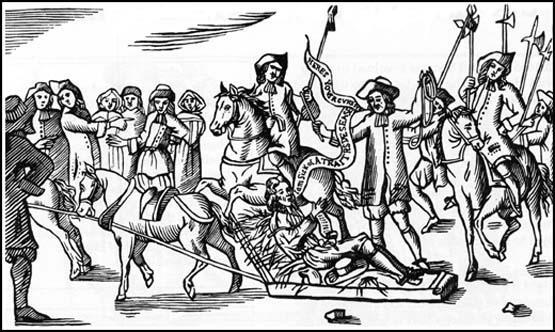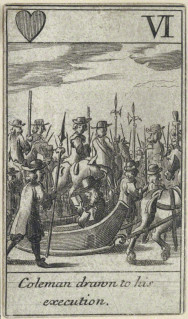
[From the archives] Jack Ketch, otherwise known as John Ketch or Richard Jaquet, began his twenty-three year career as London’s leading executioner in 1663. He was not the only executioner dispatching the condemned at Tyburn, but he was the most infamous, earning a reputation for brutality remarkable even for a man in his profession. After his death in 1686, his name became slang for any executioner, the devil, and even death itself. Over time, his reputation took on such epic proportions that he became a sort of bogeyman. So who was he?
Like many executioners, Ketch spent much of his early life on the wrong side of the law, and is known to have spent time in Marshalsea Prison. Little is definitively known about his origins. He is first mentioned in the Old Bailey proceedings in January 1676 in the case of a man who was executed for a murder taking place in Whitechapel, and who also killed the bailiff charged with arresting him. The mention is a small one, but the meaning is clear: “the jury brought him in guilty, and Jack Ketch will make him free”.

The first public reference to him appeared in the broadside The Plotters Ballad two years later. In the Receipt for the Cure of Traytrous Recusants, or Wholesome Physicke for Popish Contagion, he is represented in a woodcut depicting the execution of Edward Coleman. Accused by Titus Oates of being involved in a “Popish Plot”, he was executed for treason in December 1678. In the woodcut, Coleman is saying “I am sick of this traitorous disease.” Ketch, illustrated holding a rope and an axe, replies, “Here’s your cure sir.” (see top)
Ketch was paid for his services, and went on strike in 1682 for better wages and won. In addition to his wages, he received bribes, but he would have made most of his money by selling off pieces of the condemned. As a matter of course, executioners were given the clothes of the dead and the rope, which they sold for significant profit. A used noose could be sold for as much as a shilling an inch.
Grizzly as it sounds, execution paraphernalia was widely believed to carry serious magic and was in high demand. Even so much as a strand of a hangman’s rope was believed to cure any number of ailments when it was worn around the neck, and gamblers sought pieces to improve their luck. Nooses had been used to cure headaches by wrapping them around the temples of the afflicted since ancient Rome. The efficacy of these cures was not in question, and the public was willing to pay for whatever they could get.
Jack Ketch had a reputation of brutality and incompetence, but the truth might be more complicated than that. Although executions were highly ritualized, there was nothing in place that we might think of as “quality control,” and bribery was a more than frequent occurrence–it was the norm. Apart from his wages and the money he made from selling off pieces of the deceased, Ketch would have received a great deal of money in bribes. If the condemned had the coin, they would attempt to bribe the executioner for a swift and merciful death. There was no mechanism in place to break the neck upon hanging at this point, so many died at Tyburn of slow strangulation, a process that could take an agonizing forty-five minutes. It would have been up Ketch to set the pace of their death and to limit–or draw out–their suffering.

The condemned were not the only people bribing executioners. Following the horribly botched executions of Lord William Russell in 1683 and the Duke of Monmouth in 1685, rumors ran rampant that although both men paid Ketch to be merciful, their enemies paid him more to make them suffer. He denied the rumors, as anyone surely would, but one has to wonder how a man who made his living executing people for twenty-three years could fail at his task so spectacularly. He was no amateur, yet during the execution of poor Monmouth, Ketch struck him five times with an axe Monmouth himself is said to have proclaimed “too dull,” and in the end had to take the Duke’s head with a knife. The spectacle had been so horrific that Ketch had to make his escape under the protection of a military guard to avoid being lynched by the crowd.
For every botched execution Ketch presided over, there were several that went off without a hitch. He was said to have known ways to tie the rope that would alternately cause the victim’s neck to break quickly or to merely render them unconscious. Indeed, if the body was moved swiftly to a coffin or intercepted by friends or relatives before it was snatched by surgeons or torn apart by the blood-thirsty crowd, there was a change they might later be revived with peppermint oil. If a person was lucky enough to survive their execution, they were typically allowed to carry on living, as this was very rare. In 1709, years after Ketch’s death, John Smith was hanged at Tyburn and left there for some time before he was cut down and revived. He made a full recovery. He was allowed to live out his life and from that day was known as “Half-Hanged Smith.”
Ketch died in November of 1686. For at least the next two hundred years, his name was applied to a whole host of things related to execution. Apart from his name becoming slang for any executioner, “Jack Ketch’s Kitchen” was a name given to a room in Newgate prison where they boiled the severed limbs of those quartered for high treason. A “Jack Ketch’s Pippin” was a candidate for the gallows. A noose became, rather uncreatively, “Jack Ketch’s Necklace”, while the slum around Turnmill Street in Clerkenwell became “Jack Ketch’s Warren”.
Jack Ketch makes an appearance in my book, Tyburn, as an acquaintance of highwayman Mark Virtue. For more on Jack Ketch and the history of Tyburn as a place of execution, check out our post here.
Jessica Cale
Sources:
Ackroyd, Peter. London, The Biography.
Brooke, Alan and Brandon, Peter. Tyburn: London’s Fatal Tree.
Cassell’s Dictionary of Slang
The Old Bailey Online
The Oxford Dictionary of National Biography

Ooh my goodness!! I had no idea they lingered. How awful!
LikeLike
Such a gruesome history. Love it!
LikeLike
I will soon reach that part in your book.
In my opinion executions, in those times, were in a twisted, odd way a form of socializing, a spectacle for the people who were, are and will always be attracted by gruesome, bloody events.
LikeLike
You're absolutely right, Carmen! It would have been an especially dark kind of entertainment, but the public also did their best to take over executions, turning them into fairs as a way of rebelling against powers that be. Many of them went to the executions to show solidarity with the condemned, cheered for them and even bought them drinks at the pubs along the three mile journey from Newgate to Tyburn. Many people who were executed there hoped to go out as heroes, and may have received the only positive attention of their lives at their very public deaths. Some people even had songs written about them! Dashing highwaymen mostly, of course, but I'm sure many people would have appreciated the thought. How awful that the situation was so dire and death so common that it became entertainment and even a comfort for some.
I just read a bizarre book from the 1830s where the author actually said “hanging is the only natural death, all other deaths are accidents.” I had to read that about ten times before it sunk in. He spent the whole first chapter arguing that all people are destined to be executed in this way and that they should embrace it. I think he was nuts, but it just goes to show you the reality they were living with. It would have been so common that it wasn't even a tragedy to this man. The scale is hard to imagine.
If you're interested in reading more about the carnival atmosphere of 17th & 18th century hangings, I talk more about that in the Tyburn article I link to in the last paragraph. Thank you so much for stopping by! 🙂
LikeLike
That's not the half of it! Awful situation all around. People could be hanged for almost nothing, not to mention what was done to people for treason. Yikes!
LikeLike
So glad you enjoyed! Thanks for stopping by! 🙂
LikeLike
[…] contained serial killer. After all, the Ketch may be a reference to the 15th century executioner Jack Ketch, a name synonymous with death and the devil in English tales. Ketch is certainly taken with Mary, […]
LikeLike
Regards for this wondrous post, I am glad I detected this site on yahoo.
LikeLike
[…] this meant either purposely drawing out or shortening the suffering endured by the condemned. Jack Ketch, a 17th-century axe man in London, is perhaps the most glaring example. It’s believed Ketch […]
LikeLike
[…] this meant either purposely drawing out or shortening the suffering endured by the condemned. Jack Ketch, a 17th-century axe man in London, is perhaps the most glaring example. It’s believed Ketch […]
LikeLike
[…] Veintitrés años de carrera documentados dejaron anécdotas como la de Edward Coleman cuando fue llevado al cadalso: “Me enferma tanta traición”, dijo Coleman. “Aquí está su cura, señor”, dijo Ketch. […]
LikeLike
[…] this meant either purposely drawing out or shortening the suffering endured by the condemned. Jack Ketch, a 17th-century axe man in London, is perhaps the most glaring example. It’s believed Ketch […]
LikeLike
[…] an infamous figure in English history, held the position of official hangman during a tumultuous period of political unrest. His name became synonymous with botched executions and excessive brutality. Ketch is best […]
LikeLike
Thanks great bloog
LikeLike